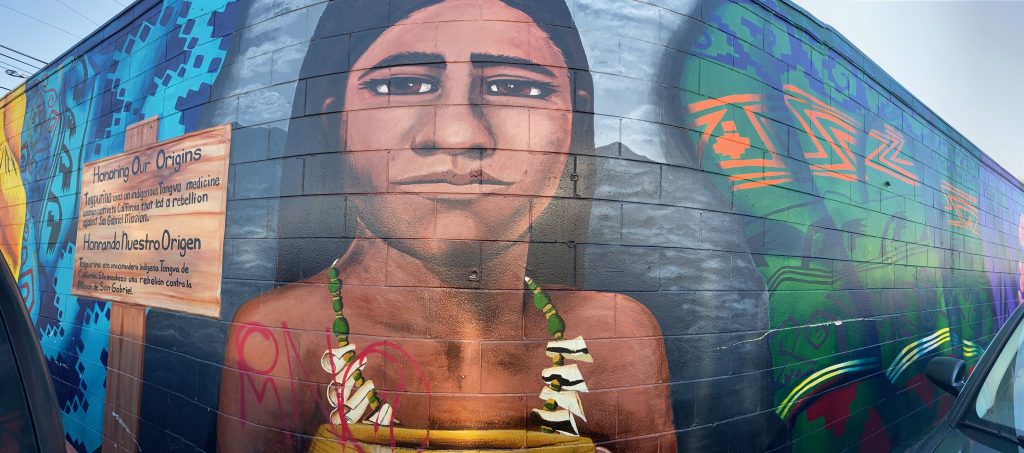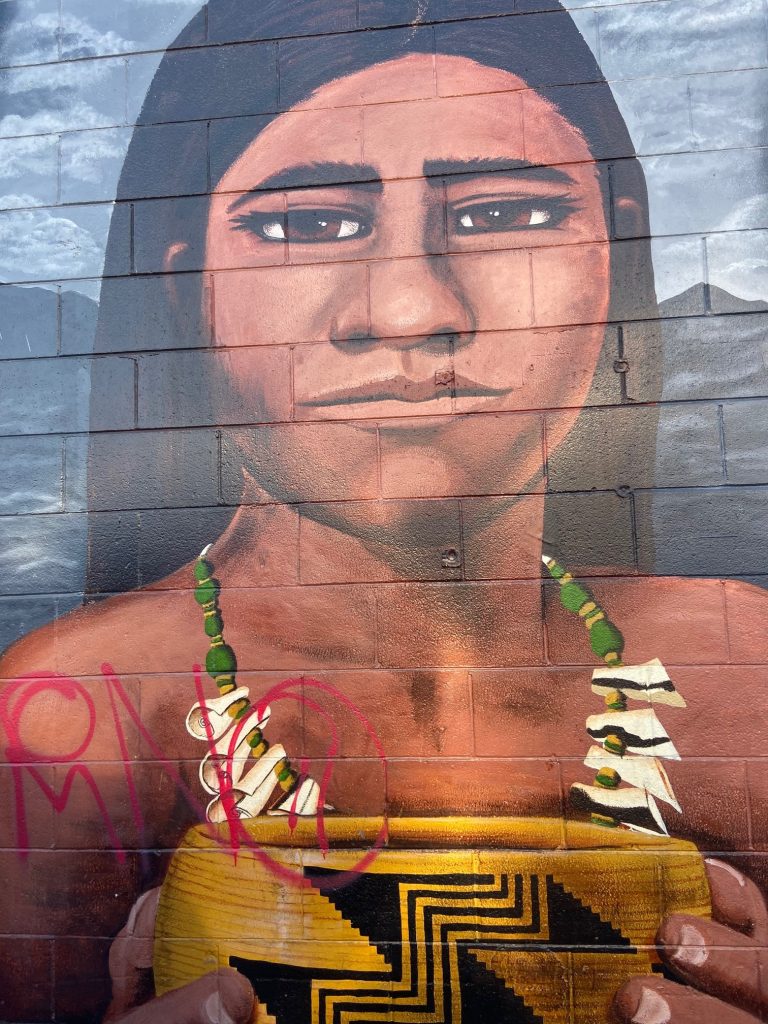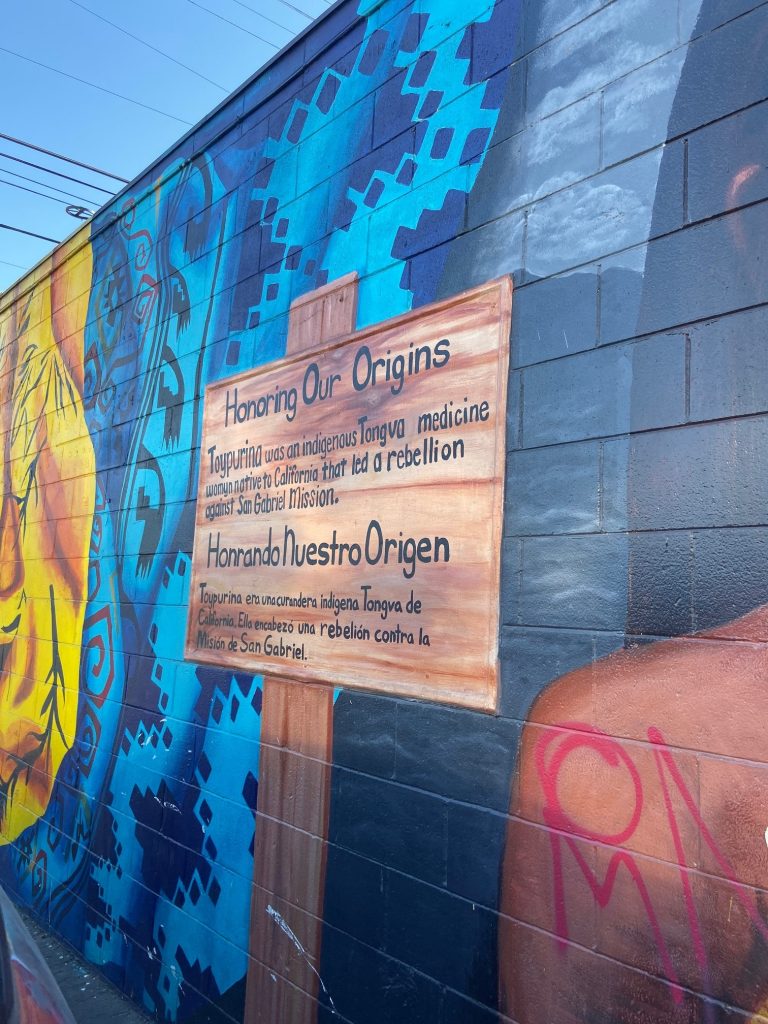Toypurina mural in Pacoima created by HOODsisters, an all womyn crew of artists and public art advocates, 2014.
Chantal Jung, photographer, 2019.
Toypurina mural in Pacoima created by HOODsisters, an all womyn crew of artists and public art advocates, 2014.
Chantal Jung, photographer, 2019.
Toypurina mural in Pacoima created by HOODsisters, an all womyn crew of artists and public art advocates, 2014.
Chantal Jung, photographer, 2019.
This video was created by the New-York Historical Society Teen Leaders in collaboration with the Untold project.
Toypurina lived in a world undergoing major changes. She was born in 1760 in Japchivit, a Tongva community located in what is today known as the San Gabriel Valley in California. At the time of her birth, around 5,000 Tongva people lived in the valley and surrounding area. They lived in small, independent communities that competed with one another for the limited resources the valley offered.
When Toypurina was 11 years old, Spanish Franciscan monks arrived to colonize the valley for Spain. When they entered a new territory, they would establish a mission, baptize the local Native people into the Catholic Church, and then force them to adopt the Spanish way of life. The Franciscans who came to Toypurina’s area built the San Gabriel mission, the fourth mission in the area the Spanish called Alta California.
Between 1772 and 1785 the Franciscans baptized about 1,200 Native people from area around San Gabriel. They called the baptized Tongva “Gabrielinos.” 843 Gabrielinos moved into the mission, which caused huge changes to life in the San Gabriel Valley. The mission’s farms took over land the Tongva used to hunt, and the mission’s sheep destroyed the local ecosystem. Tongva communities that did not join the Franciscans were left with fewer resources.
By 1785 Japchivit was struggling to survive. Toypurina’s brother was the leader of Japchivit, so she was well-informed about the problems the mission had created for her people. She herself was well respected by other Tongva communities for her widsom. Together, Toypurina and her brother looked for a way to help their community stand up to the mission.
Meanwhile, Nicholás José, a Gabrielino who lived at San Gabriel, was also frustrated with the mission. Nicholás had lost two wives, a child, and one third of his home village of Silbapet to the European diseases the Franciscans brought to the valley. He wanted to perform the traditional Tongva dance that would help the spirits of the dead transition to the afterlife, but the Spanish would not let Gabrielinos practice any of their old traditions. Nicholás tried to rebel against this rule in the early 1780s, but he was caught and punished. He knew if he wanted to be successful, he would need the support of the Native people who lived outside the mission.
In the summer of 1785, Nicholás sent Toypurina beads as an offering and asked her to support his plot to rebel against the mission. Toypurina agreed to help. She brought eight villages into the plot. One village leader, Alihivit of Jajamovit, later confessed that he joined because he wanted to see if everyone would actually do it. Another leader, Temejasaquichí of Juvit, was more of a true believer. Temejasaquichí snuck into the mission San Gabriel to speak with the Gabrielinos. He told them they should follow Toypurina instead of the Franciscan priests. This secret meeting might have been the rebellion’s undoing. Someone informed the mission leadership that an uprising was being planned, and gave them all the information they needed to capture the plotters.
On October 25, 1785, warriors from the eight allied Tongva villages set out to kill the mission leaders. Toypurina went with them. She had no intention of fighting, but she believed her presence would inspire the warriors. Unaware that someone had given away their plan, the attack party walked right into a trap set by the mission guards. At least twenty-one people were captured, including Toypurina.
When the governor of Alta California heard of the failed rebellion, he went to the mission to personally oversee the investigation. Seventeen captives were brutally whipped in public and sent back to their villages to serve as a warning to other would-be rebels. Toypurina, Nicholás, Temejasaquichí, and Alihivit were identified as the leaders of the plot, and held for further questioning.
During her interrogation, Toypurina told the governor that she participated in the rebellion because “she was angry with the Padres and with all of those of this Mission because we are living here in her land.” Her wording reveals that it was not just the Spanish she viewed as her enemies. She was also angry at the Gabrielinos who lived in the mission and disrupted her community’s way of life.
Toypurina’s banishment cut her off from her entire community and culture, and left her dependent on the Spanish for her survival.
In January 1786 the governor sent his trial records to the commandant general of New Spain so he could send back his recommendations for punishment. During the two years it took to receive an answer, Toypurina was held prisoner at the Mission San Gabriel. In March of 1787, Toypurina was baptized. In the trial records there is a note from the governor explaining that some Tongva wanted to kill Toypurina for her part in the failed rebellion. It is possible she got baptized so the mission leaders and Spanish government would protect her, but we’ll never know for sure.
In June 1788, the orders of the commandant general arrived. Temejasaquichí and Alihivit were given stern warnings and returned to their communities. Nicholás was banished from the San Gabriel Valley. He was sent to a Spanish military settlement, where he was sentenced to work for six years without pay. Toypurina was banished to the colony’s most remote mission, the Mission San Carlos Borromeo de Carmelo.
Toypurina’s banishment cut her off from her entire community and culture, and left her dependent on the Spanish for her survival. She did her best to build new ties in her new home. Within a year she married a Spanish soldier. After her marriage, she moved around Alta California frequently, following him from post to post. Their first and second children were born at the Mission San Luis Obispo. Their third child was born in 1794 at the Mission San Carlos Borromeo de Carmelo. On May 22, 1799, Toypurina died at the Mission San Juan Bautista. She was only 39 years old.
Vocabulary
- Alta California: The section of New Spain that extended up the Pacific coast to present day Sonoma.
- banish: Send someone away from a place as a punishment.
- baptize: To undergo a special ceremony to be admitted to a Christian community.
- Catholic Church: The Christian religious group that follows the authority of the Pope in Rome.
- Franciscan: A person who belonged to the Order of St. Francis, a Catholic religious order famous for its preaching and missionary work.
- Gabrielinos: The name given to Native people who were baptized and came to live in the Mission San Gabriel.
- Japchivit: A Tongva community located northwest of Mission San Gabriel.
- mission: Small agricultural communities run by Spanish religious leaders that housed local Native populations while they were educated in the Spanish way of life.
- Mission San Carlos Borromeo de Carmelo: Mission located at the mouth of the Carmel River, near modern-day Monterey, California. Headquarters for the mission system in Alta California.
- Mission San Juan Bautista: Mission located northeast of Mission San Carlos Borromeo, in an area known today as San Juan Bautista, California.
- Mission San Luis Obispo: Mission located south of Mission San Carlos Borromeo, in an area known today as San Luis Obispo, California.
- padres: Priests
- Tongva: The preferred name for the Native group previously known at the Gabrielino or Fernandeño. The Tongva originally lived in a territory covering the present-day Los Angeles Basin and South Channel Islands. Today, there are Tongva communities in California.
Pronunciation
- Alihivit: ah-lee-HEE-weet
- Gabrielinos: gab-REE-ell-EE-nohs
- Jajamovit: ha-ha-mo-weet
- Japchivit: ZHAP-chi-weet
- Juvit: SHU-u-eet
- Silbapet: sill-bah-PET
- Temejasaquichí: TEH-mah-shah-sah- KEY- ch-EE
- Tongva: TON-guh
- Toypurina: toy-purr-EE-nuh
Discussion Questions
- Why did Toypurina agree to attack the San Gabriel mission?
- Why was banishment an extreme punishment for Toypurina?
- What does this life story reveal about the choices available to Native people in the mission system?
Suggested Activities
- In 2014, the HOODsisters artists collective painted the mural of Toypurina that accompanies this life story. After reading the life story, ask students to examine the artwork and consider the following questions. How does this artwork reflect Toypurina’s life and experiences? How does it connect her story with modern-day Los Angeles? Why is it significant that this mural was made by an all-womyn collective? Why is it important to create representations of people who lived long ago? What are the downsides of contemporary images of historical people?
- Compare and contrast the HOODsisters mural with a second Toypurina mural that stands in the Los Angeles housing complex Ramona Gardens. What are the differences between these two works? What do these differences reveal about Toypurina’s legacy?
- In 1958, historian Thomas Workman Temple II published a highly dramatized version of Toypurina’s life, which remains the dominant narrative to this day. While it is a much more exciting account, the vast majority of it is not true. Ask the students to read a version of Toypurina’s story based on Temple’s work, and compare it with this one. What might have motivated Temple to change the story? Why is it important to know the actual story? What does this comparison tell us about historical research and writing?
- Dig deeper: Ask students to read the trial documents relating to Toypurina’s uprising. What do they reveal about the attitudes of the Spanish toward Native people? Why is it important to read the original documents whenever possible?
- Toypurina and her compatriots were not the first Native people to revolt against the mission system in New Spain. Teach this life story together with the pots from the Pueblo Revolt for a larger lesson about Native resistance in New Spain.
- Native people across North and South America had a variety of responses to the arrival of European colonizers. Combine this life story with any of the resources below for a larger consideration of way Native communities responded to colonization: Life Story: Weetamoo, Life Story: Malitzen (La Malinche), Life Story: The Gateras of Quito, Life Story: Kateri Tekakwitha, Life Story: Quashawam, Revolution in Art, Life Story: Marguerite Faffart, Selling Staten Island, Quapaw Masterpiece, Frontier Diplomacy, Life in the Mission System, Life Story: Tituba, and Life Story: Mother Esther Marie-Joseph Wheelwright de l’Enfant.
- Toypurina’s children were some of many mixed-race people were born in the North American colonies. Combine this document with any of the following resources to learn more about the origins and experiences of this group of people: Fashionable Rebellion, Settling Russian Alaska, Runaway Slaves, Legislating Reproduction and Racial Difference, Life Story: Malitzen (La Malinche), Education in New France, Women and the Code Noir, Instructions for the New World, Life Story: Marguerite Faffart, Purity of Blood, Life Story: Nansi Wiggins.
- Religion was a powerful force in the daily lives of many people in the European colonies of the Americas. For some, it offered a way to escape the confined of expected gender roles, and for others, it was a corrosive force. Combine this life story with any of the following resources for a lesson on colonial women and religious life: Life Story: Doña Teresa de Aguilera y Roche, Witchcraft in Bermuda, The Mourning Poetry of Anne Bradstreet, Life Story: Lady Deborah Moody, Ornaments of the Daughters of Zion, Life Story: Mother Esther Marie-Joseph Wheelwright de l’Enfant, Life Story: Kateri Tekakwitha, A Nun Challenges the Patriarchy, Life Story: Susanna Wright, Life Story: Tituba, Life in the Mission System, Eighteenth-Century Education, Life Story: Margrieta van Varick, and Life Story: The Public Universal Friend.
Themes
POWER AND POLITICS; ACTIVISM AND SOCIAL CHANGE
New-York Historical Society Curriculum Library Connections
- For resources relating to the Spanish colonies in the Americas, see Nueva York: 1613–1945.









